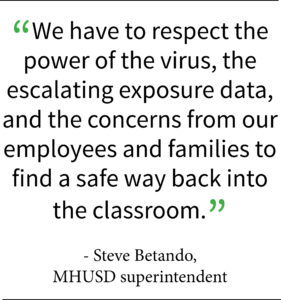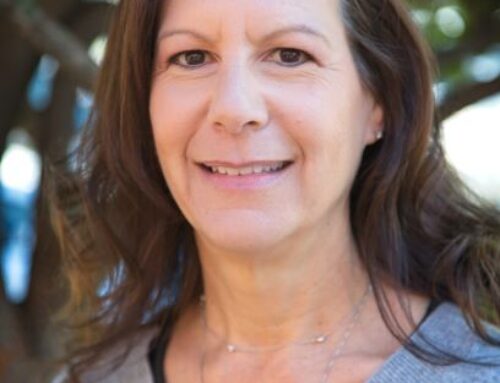Rising COVID-19 cases in county forces school district to keep students, staff at home

By Marty Cheek
In mid-March when COVID-19 forced students in Santa Clara County to transition overnight to online learning, many parents and teachers hoped it would be a temporary inconvenience. In mid-July, with infection rates dramatically rising, the pandemic is not yet under control and is growing worse. That means when the new school year starts, many classes across the county will continue to meet via video-conferencing systems and not in-person, including in Morgan Hill.
 When the 2020-2021 school year opens Aug. 13, students in the Morgan Hill Unified School District will continue the virtual learning program in an effort to keep them socially distanced and prevent the spread of the coronavirus. All students in grades pre-K through high school seniors will have access to a Chromebook. District staff acquired for those students without Internet access 400 “hot-spots” to make sure that they can connect to their classroom lectures and activities.
When the 2020-2021 school year opens Aug. 13, students in the Morgan Hill Unified School District will continue the virtual learning program in an effort to keep them socially distanced and prevent the spread of the coronavirus. All students in grades pre-K through high school seniors will have access to a Chromebook. District staff acquired for those students without Internet access 400 “hot-spots” to make sure that they can connect to their classroom lectures and activities.
“We have to respect the power of this virus, the escalating exposure data, and the concerns from our employees and families to find a safe way back into the classroom,” said MHUSD Superintendent Steve Betando. “It is heartbreaking for all of us to not be able to bring the students back to in-person education at the start of the school year.”
A month ago, the outlook was more optimistic. The county of Santa Clara Public Health Department on June 30 issued a 22-page document that provided detailed guidance for school administrators to help them prepare to welcome students back to school campuses in fall if it was not a safety risk. But as the number of coronavirus cases started to grow in recent weeks, all districts throughout the county elected to keep campuses closed and continue online learning. As of July 24, Santa Clara County has had 8,533 coronavirus cases, with 181 deaths. Morgan Hill has seen 207 confirmed cases since the pandemic started.
The district is preparing for the possibility the entire school year will require online learning. But the administration also remains flexible with the hope that circumstances (such as a significant decrease in the numbers or an effective vaccine is found) might allow students to physically attend classrooms in their schools in ways that prevent spread of the virus, he said.
Society has built a dependence on children going to school on a certain schedule, so the transition of students learning at home has impacted many families, especially those with a single parent or where both parents must work to financially support the household.
“Most of the workforce in our society has depended on public education for their childcare while people work,” Betando said. “It has not only affected the learning environment because kids need to shelter in place and not come together in large groups in classrooms, but it’s affecting peoples’ ability to go to work, even if they can go to work health-wise. Everything is tied together and the virus has essentially dissolved those links because they’re interdependent on one another.”
To help families in need, the school district’s Student Nutrition Department will continue to provide free Grab ‘n’ Go meals for pick-up for eligible students. MHUSD is also looking at ways to provide childcare support for families in financial need. This will most likely be based on the essential worker childcare program it opened in the spring.
The school culture is also more than just learning. There is a social aspect to it where students enjoy activities such as sports, theater plays, music and other non-academic endeavors. With the COVID-19 threat, many of these won’t be able to happen because of social distancing.
MHUSD did hold summer camps that allowed children to participate under public order with constraints. This interaction with other students is especially necessary for the social development of young boys and girls in the elementary grades, and so it is a challenge to find ways to safely do activities while social distancing.
Lanae Bays, the communications coordinator for MHUSD, has two children, ages 11 and 14, in district schools. As a parent, she encourages mothers and fathers to be patient in dealing with the brave new world of coronavirus — and expect changes to occur in the coming months that they must be flexible to adapt to.
She sympathizes with the many parents who are in circumstances that make it hard for them to help their children learn at home while in COVID-19 shelter in place. From reading comments on social media, she sees how many families are put in a predicament of balancing a job to pay the bills and raising children during the time of a pandemic.
“There are parents who are single parents who are wondering ‘How am I going to help my student with their schoolwork when I have to go to work?’” Bays said. “I thought, it’s going to be a challenge for me but I’m in a two parent households, so we can probably make something work . . . The only advice I can give is just to be resourceful and patient and be ready for anything, as we have all been doing this entire time. If this time in the world has taught me anything, it’s really just to be prepared to pivot.”
The pandemic is also hard on teachers who have dedicated their lives to teaching young people. They now must do instruction by looking at their faces on a computer screen on a Zoom meeting rather than in person with each student sitting at a desk. Some MHUSD instructors and staff have health situations, however, requiring to stay a safe distance from their students who might carry the COVID-19 germ.
Educators want to “return to normalcy” and teach their students in their classrooms as they have done most of their careers, said Jim Levis, a Britton Middle School science teacher.
“Unfortunately, COVID cases have continued to increase and there is no sign of them easing,” he said. “The risks to our students, our staff, and our community are too high to return to campus at this time.”






